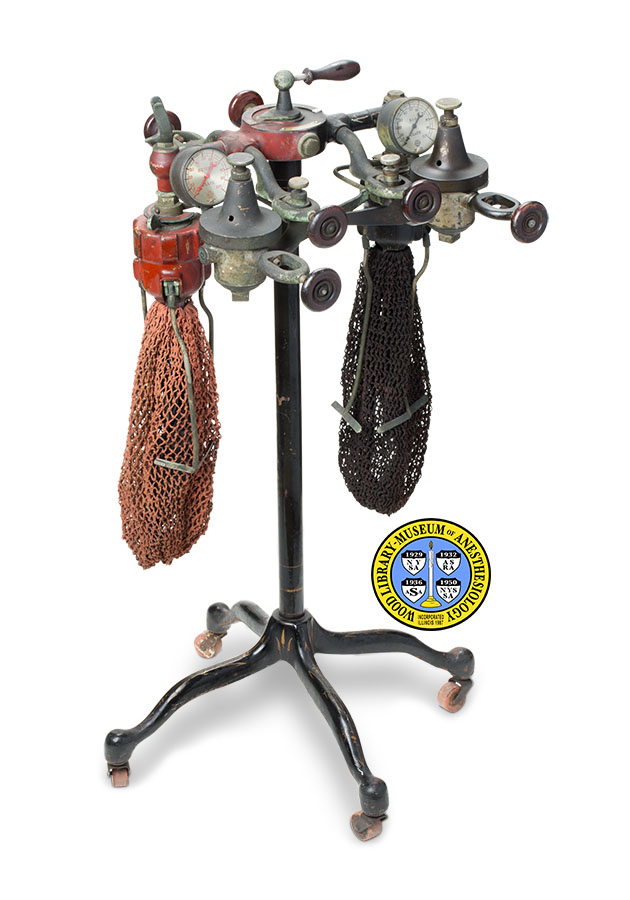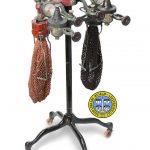Clark New Model
Chicago inventor Albert Charles Clark founded the dental equipment firm, A. C. Clark & Company, in 1895. From 1904 into the 1920s, Clark also made anesthesia machines. Their original model, the Clark Correct Apparatus, was one of the first in the world to administer what would become the standard triad of agents, ether, nitrous oxide and oxygen. Through the 1910s, Clark marketed its New Model Gas Outfit, and the more compact Baby Clark Gas Outfit. But the tide was already turning against this pioneer. Around 1910, Elmer I. McKesson, M.D. (1881-1935) modified the Clark regulating valve, founded his own company, and launched a new generation of anesthesia machines.
Catalog Record: Clark New Model Clark New Model
Access Key: amws
Accession No.: 447
Title: [Clark New Model Gas Outfit] / A. C. Clark & Co.
Corporate Author: A. C. Clark & Co.
Publisher: Chicago, Ill. : A. C. Clark & Co., [between 1910 and 1920?].
Physical Description: 1 anesthesia apparatus : metals, rubber, wood, paint ; 93 x 43.5 x 51 cm.
Subject: Anesthesia, Inhalation.
Subject: Anesthesia Machines.
Subject: Nitrous Oxide.
Subject: Oxygen.
Subject: Ether, Ethyl.
Web Link: https://www.woodlibrarymuseum.org/museum/item/1009/clark-new-model
Note Type: General
Notes: The date range is based on the earliest and latest descriptions of the Clark New Model Gas Outfit that were found by the cataloger. The front of the apparatus is considered that side on which the gauges can be read. This is the orientation in which the object is described.
Note Type: Citation
Notes: Clark AC, inventor; Anesthetic apparatus; US patent 1,167,563. January 4, 1916.
Note Type: Citation
Notes: A. C. Clark & Company File. Archives. Located at: Wood Library-Museum of Anesthesiology, Schaumburg, Illinois.
Note Type: Citation
Notes: Coburn RC. Nitrous oxide analgesia in labor. New York State Journal of Medicine. February, 1919; 19(2):37-40.
Note Type: Citation
Notes: Davison MHA. The evolution of anaesthesia (Part 2). British Journal of Anaesthesia. October 1958;30(8):504.
Note Type: Citation
Notes: Eger EI, 2nd., Ed. Nitrous Oxide / N2O. New York: Elsevier, 1985.
Note Type: Citation
Notes: McKesson EI. Nitrous oxid-oxygen anaesthesia; with a description of a new apparatus. Surgery, Gynecology and Obstetrics. October, 1911; 13: 456-462.
Note Type: Physical Description
Notes: One anesthesia apparatus; The head of the unit is mounted on a pole with a four-armed base; Each arm of the base holds a small rubber wheel; The pole and base are painted black, with gold decoration; An adhesive label on the pole reads: “A. C. CLARK & CO. [new line] MAKERS [new line] CHICAGO-USA”;
The head of the unit is mounted at the top of the pole, with the control dial in the center; The control dial is painted red on the left and black on the right; These colors are applied in the shape of crescents which overlap in the center of the dial; This dial is marked, from left to right: “OFF, OX, N2O, OFF”; The accession number “447” is painted on the right side of the dial; A small metal plate is affixed to the dial; This plate reads “NEW CLARK [new line] PAT. IN U.S. AND FOREIGN COUNTRIES [new line] OTHER PATENTS PENDING [new line] A. C. CLARK & CO., CHICAGO, ILL”; A wooden control knob is mounted at the top of a post in the center of the dial;
One connecting bar extends to the left of the dial and another extends to the right; The bar on the left holds an oxygen regulator, painted red; The bar on the right holds a nitrous oxide regulator, painted black; An adhesive label on the back of the nitrous oxide regulator reads: “A. C. CLARK & CO. [new line] MAKERS [new line] CHICAGO-USA”; Each regulator has a control dial of its own, each with a flange grip; Each of the regulator dials is marked: “1, 2, 3, 4, 5, 6, 7, 8, 9, 10”;
Each of the connecting bars, to left and right of the dial, holds two curved crossbars (one in front and one in back); This configuration gives the impression of two oxbows or two sets of bicycle handles; These crossbars are mounted close to the dial; Each of the two crossbars in back ends in a cylinder yoke with a wooden knob (that on the left connects to the oxygen regulator, while that on the right connects to the nitrous oxide regulator); Each of the crossbars in front ends in a yoke that holds a valve (that on the left connects to the oxygen regulator and that on the right connects to the nitrous oxide regulator); Each of these yokes has metal control knob marked: “FOR [new line] EXTRA [new line] PRESSURE”;
The top of each valve has a control knob marked with the word “ON” and a directional arrow; Each of these valves holds two further components, a pressure gauge mounted behind the valve and a cylinder yoke in front; The face of the oxygen gauge is marked: “OXYGEN [new line] 0, 5, 10, 20, 30, 40, 50, 60, 70, 80, 90, 100 [new line] CLARK”, followed by the logo of the U. S. Gauge Co.; The face of the nitrous oxide gauge is marked: “N2O [new line] 0, 5, 10, 20, 30, 40, 50, 60, 70, 80, 90, 100 [new line] CLARK”, followed by the logo of the U. S. Gauge Co.; Each of the four yokes in front is equipped with a wooden knob;
Each regulator is intended to hold a rebreathing bag surrounded by a woven net; For purposes of photography, this machine was married to net bags from another Clark machine in the collection; The red net bag was attached to the oxygen regulator, and the black net bag was attached to the nitrous oxide regulator; Three metal retaining bars or “arms” dangle from each regulator; These arms are intended to keep the bags from over-inflating.
Note Type: Reproduction
Notes: Photographed by Mr. Steve Donisch, January 14, 2016.
Note Type: Historical
Notes: The dental equipment firm, A. C. Clark & Company, was founded in Chicago in 1895. From 1904 into the 1920s, Clark also made anesthesia machines. Their original model, the Clark Correct Apparatus, was one of the first in the world to administer what would become the standard triad of agents, nitrous oxide, oxygen and ether.Through the 1910s, Clark marketed its New Model Gas Outfit, and the more compact Baby Clark Gas Outfit. But the tide was already turning against this pioneer. Around 1910, Elmer I. McKesson, M.D. (1881-1935) modified the Clark regulating valve, founded his own company, and launched a new generation of anesthesia machines.
Note Type: Exhibition
Notes: Selected for the WLM website.


